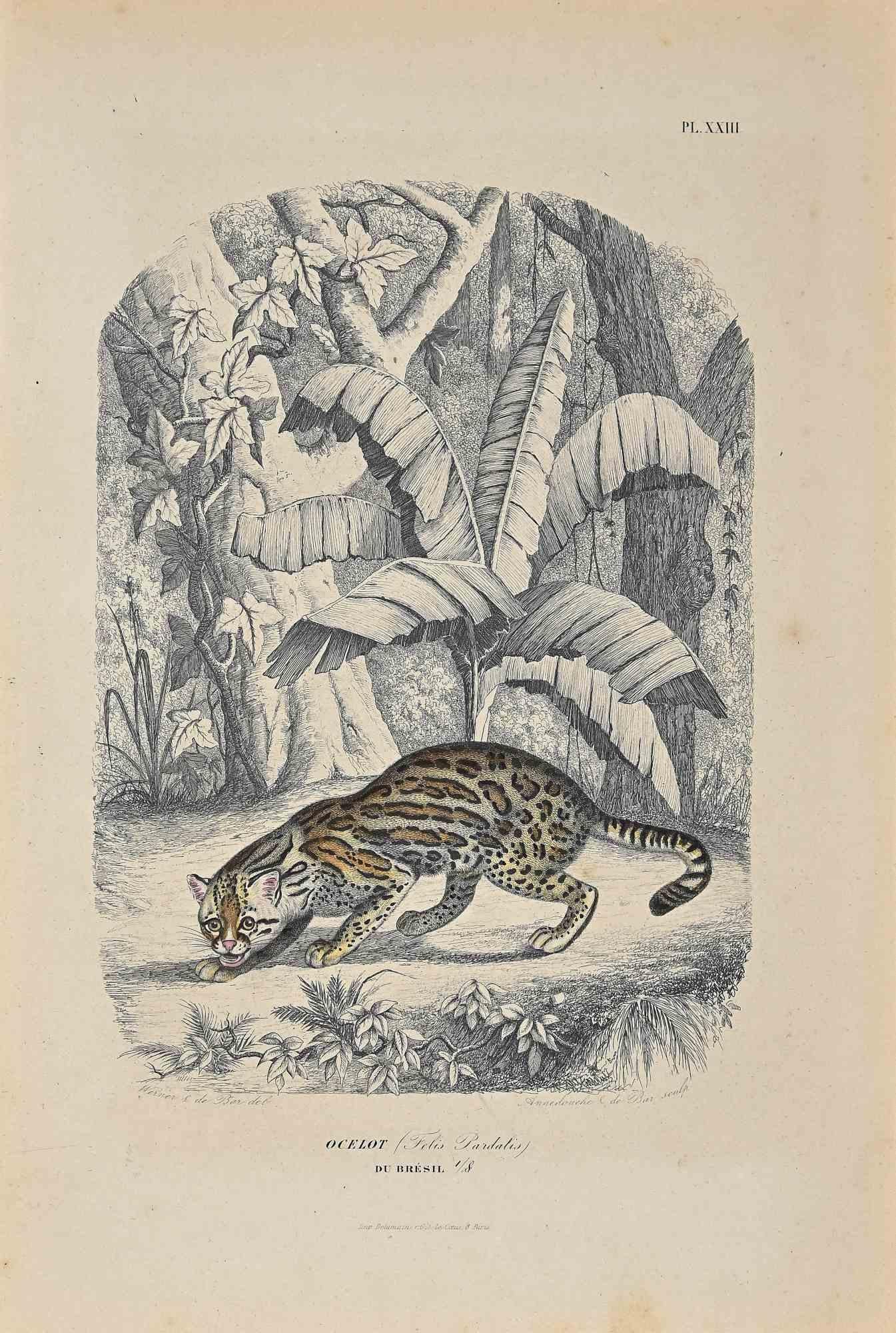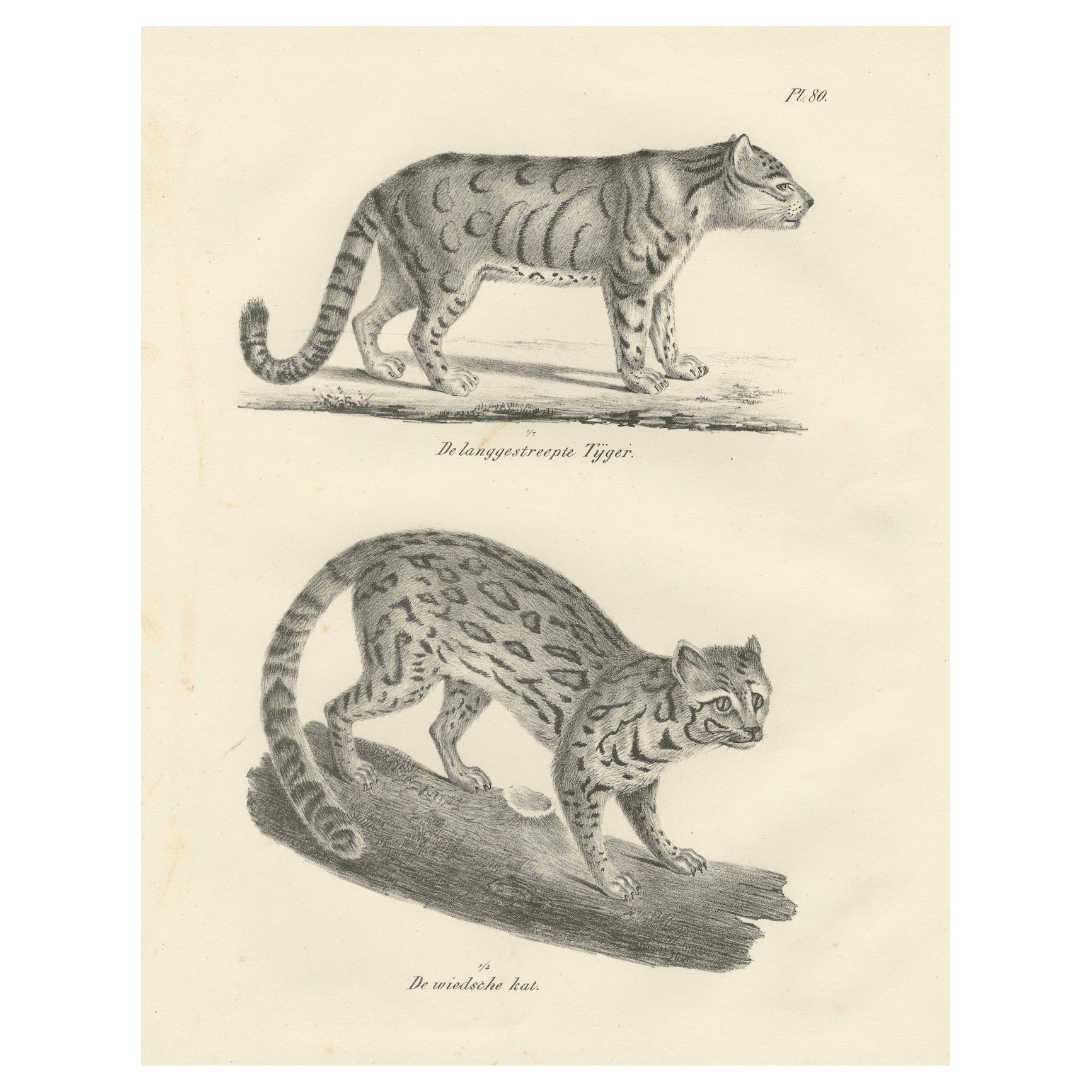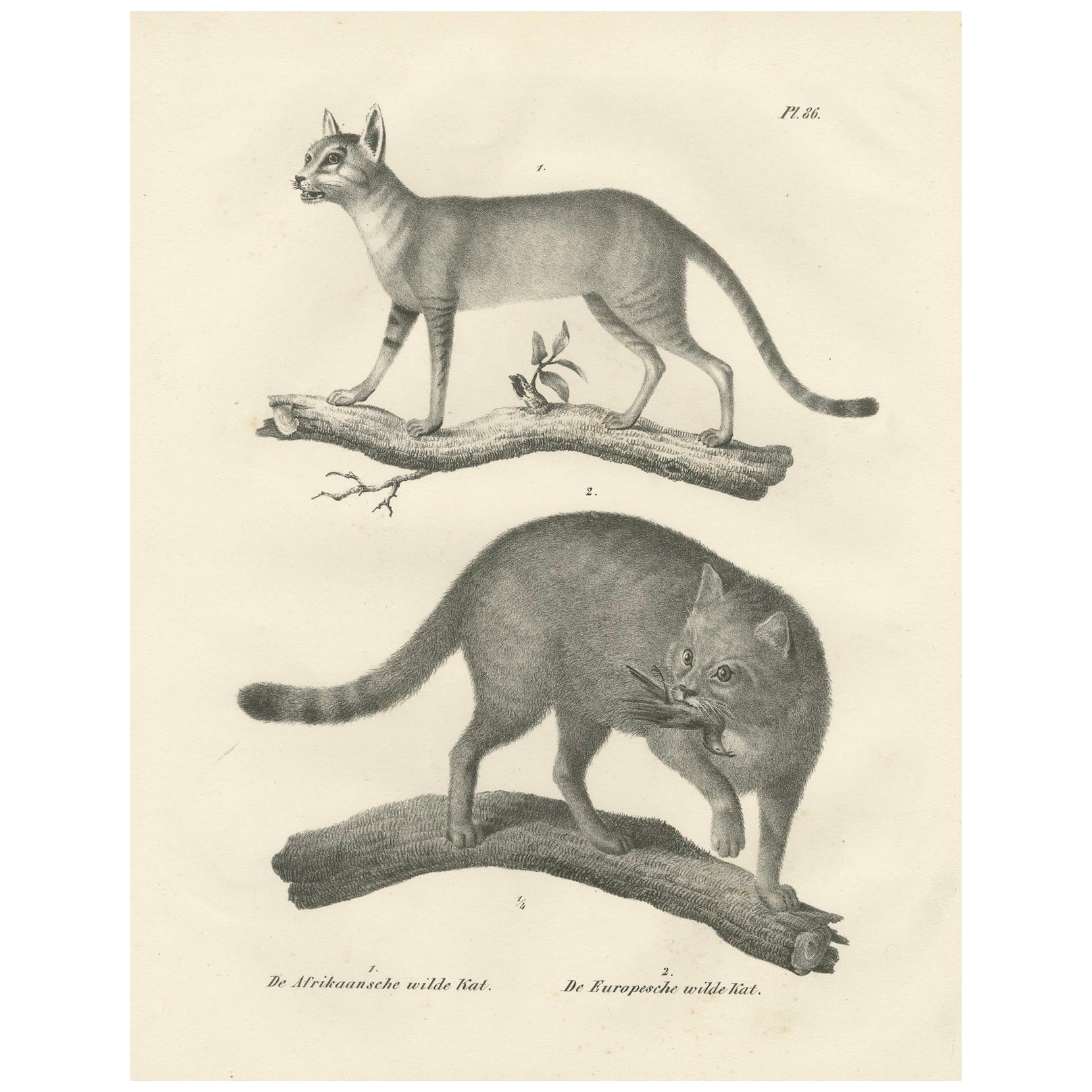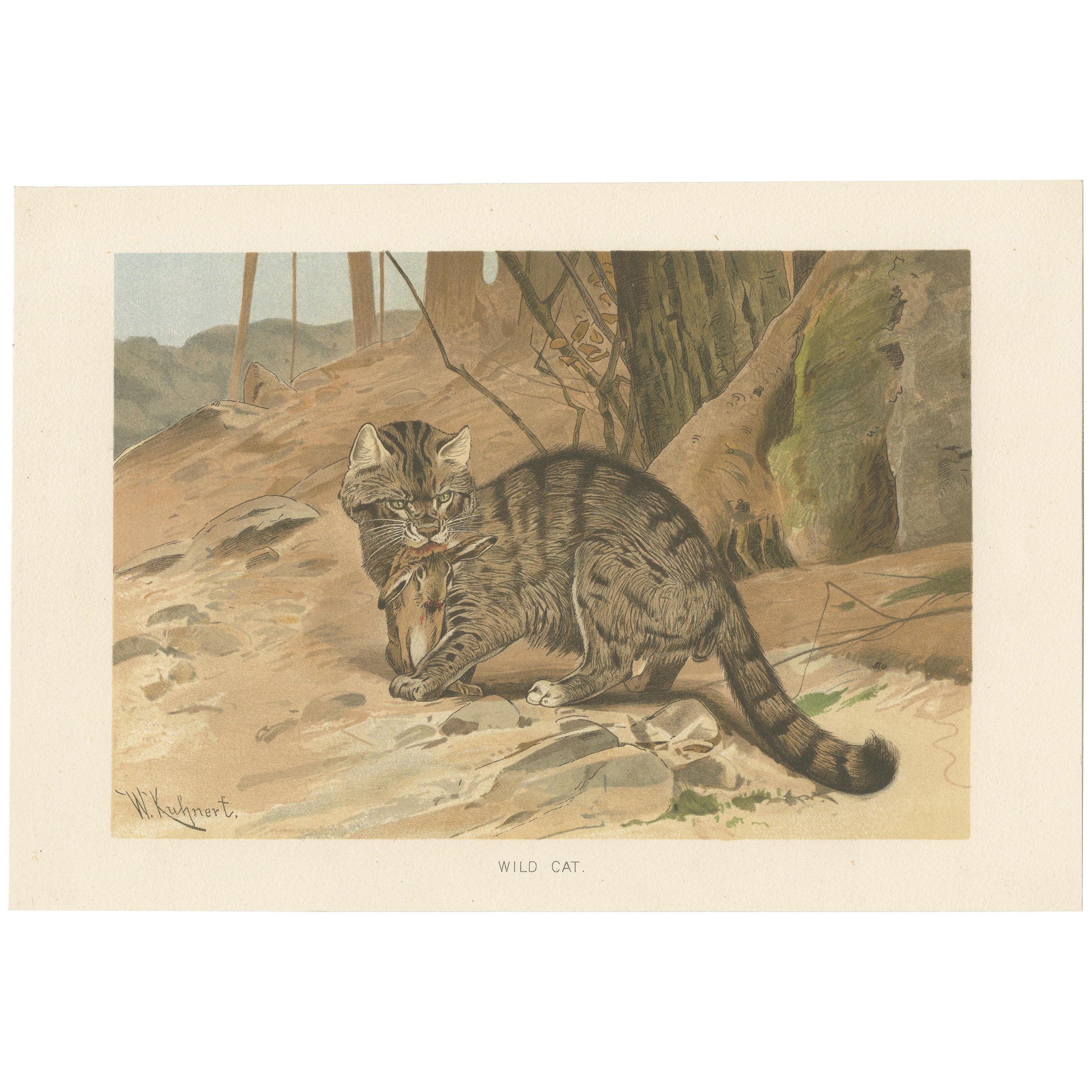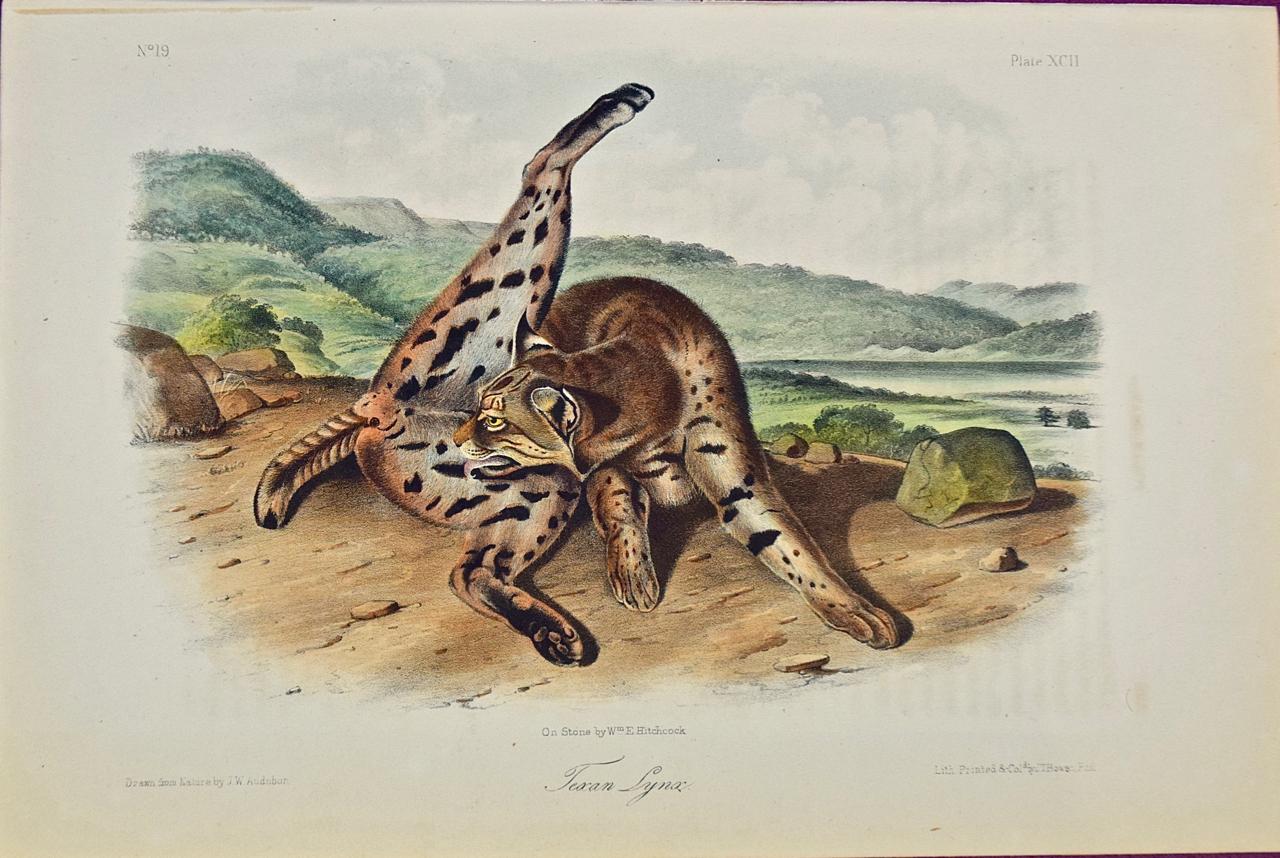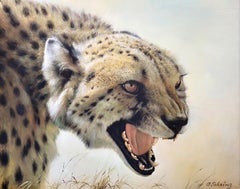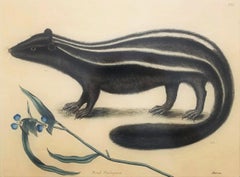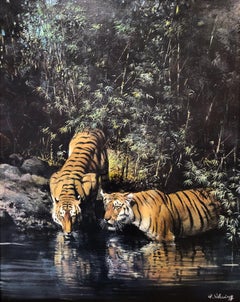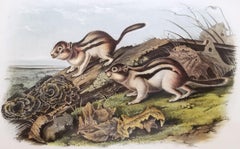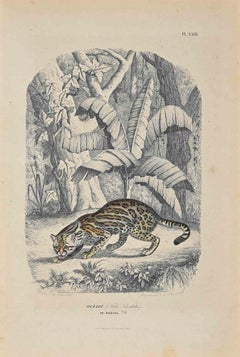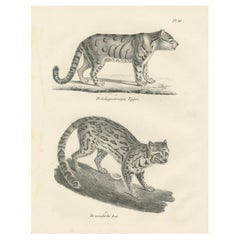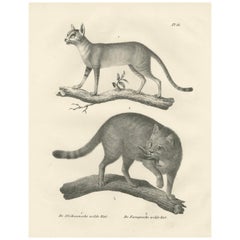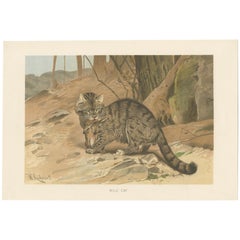Items Similar to Felis Rubiginosa (Rusty-Spotted Cat) /// Daniel Giraud Elliot Cat Tiger Lion Art
Want more images or videos?
Request additional images or videos from the seller
1 of 20
Daniel Giraud ElliotFelis Rubiginosa (Rusty-Spotted Cat) /// Daniel Giraud Elliot Cat Tiger Lion Art1878-1883
1878-1883
$2,400
£1,818.46
€2,086.53
CA$3,377.19
A$3,712.46
CHF 1,951.10
MX$45,082.76
NOK 24,339.45
SEK 23,059.92
DKK 15,572.33
About the Item
Artist: Daniel Giraud Elliot (American, 1835-1915)
Title: "Felis Rubiginosa (Rusty-Spotted Cat)" (Plate: XXIX - 29)
Portfolio: A Monograph of the Felidae or Family of the Cats
Year: 1878-1883 (First edition)
Medium: Original Hand-Colored Lithograph on heavy unbranded wove paper
Limited edition: Unknown
Printer: Taylor and Francis; M. & N. Hanhart, London, UK
Publisher: Daniel Giraud Elliot, London, UK
Reference: Nissen ZBI No. 1279; McGill/Wood page 332
Sheet size: 18.88" x 23.69"
Image size: 14.5" x 19.5"
Condition: A few tiny spots of discoloration in upper sky. Has been professionally stored away for decades. In excellent condition with strong colors
Rare
Notes:
Provenance: private collection - Aspen, CO. Lithography by Dutch artist Joseph Smit (1836-1929) after a drawing by German artist Joseph Wolf (1820-1899). Comes from Elliot's one volume "A Monograph of the Felidae or Family of the Cats", (1878-1883) (First edition), which consists of 43 hand-colored lithographs, originally issued in 11 parts. Printed in one color from one stone plate: black.
The rusty-spotted cat (Prionailurus rubiginosus) is one of the cat family's smallest members, of which historical records are known only from India and Sri Lanka. In 2012, it was also recorded in the western Terai of Nepal. Since 2016, the global wild population is listed as Near Threatened on the IUCN Red List as it is fragmented and affected by loss and destruction of its prime habitat, deciduous forests.
Biography:
Daniel Giraud Elliot (March 7, 1835 – December 22, 1915) was an American zoologist and the founder of the American Ornithologist Union. He was born in New York City on March 7, 1835, to George and Rebecca Elliot. In 1858, he married Ann Eliza Henderson. From 1869 to 1879, he was in London and established strong links to British ornithologists and naturalists. Elliot used his wealth to publish a series of sumptuous color-plate books on birds and other animals. Elliot wrote the text himself and commissioned artists such as Joseph Wolf and Joseph Smit, both of whom had worked for John Gould, to provide the illustrations. The books included "A Monograph of the Phasianidae (Family of the Pheasants)" (1870–72), "A Monograph of the Paradiseidae or Birds of Paradise" (1873), "A Monograph of the Felidae or Family of Cats" (1878) and "Review of the Primates" (1913). In 1890, he was President of the American Ornithologists' Union. Elliot became the first curator of zoology at the Field Museum in Chicago, and in 1896, accompanied by Carl Akeley, led the museum's expedition to Somaliland, the first African zoological collecting expedition to be mounted by a North American museum. In 1899, Elliot was invited to join the elite Harriman Alaska Expedition to study and document wildlife along the Alaskan coast. Elliot was one of the founders of the American Museum of Natural History in New York City, of the American Ornithologists' Union and of the Société zoologique de France. He died in New York City on December 22, 1915, of pneumonia.
- Creator:Daniel Giraud Elliot (1835 - 1915, American)
- Creation Year:1878-1883
- Dimensions:Height: 18.88 in (47.96 cm)Width: 23.69 in (60.18 cm)
- Medium:
- Movement & Style:
- Period:
- Condition:
- Gallery Location:Saint Augustine, FL
- Reference Number:1stDibs: LU121215087512
About the Seller
5.0
Platinum Seller
Premium sellers with a 4.7+ rating and 24-hour response times
Established in 1978
1stDibs seller since 2015
1,349 sales on 1stDibs
Typical response time: <1 hour
- ShippingRetrieving quote...Shipping from: Saint Augustine, FL
- Return Policy
Authenticity Guarantee
In the unlikely event there’s an issue with an item’s authenticity, contact us within 1 year for a full refund. DetailsMoney-Back Guarantee
If your item is not as described, is damaged in transit, or does not arrive, contact us within 7 days for a full refund. Details24-Hour Cancellation
You have a 24-hour grace period in which to reconsider your purchase, with no questions asked.Vetted Professional Sellers
Our world-class sellers must adhere to strict standards for service and quality, maintaining the integrity of our listings.Price-Match Guarantee
If you find that a seller listed the same item for a lower price elsewhere, we’ll match it.Trusted Global Delivery
Our best-in-class carrier network provides specialized shipping options worldwide, including custom delivery.More From This Seller
View AllAttacking Cheetah /// African Wildlife Safari Big Cat Animal Portrait Painting
By Adolf Sehring
Located in Saint Augustine, FL
Artist: Adolf Sehring (Russian/German-American, 1930-2015)
Title: "Attacking Cheetah"
Series: Wildlife
*Signed by Sehring lower right
Circa: 1990
Medium: Original Oil Painting on Can...
Category
1990s Contemporary Animal Paintings
Materials
Canvas, Paint, Oil
Putorius & Pseudo Phalangium (The Pole-Cat) (Skunk) /// Mark Catesby Animal Art
By Mark Catesby
Located in Saint Augustine, FL
Artist: Mark Catesby (English, 1638-1749)
Title: "Putorius & Pseudo Phalangium (The Pole-Cat) (Skunk)" (Plate/Tab 62)
Portfolio: Natural History of Carolina, Florida & the Bahama Islands
*Monogram signed by Catesby in the plate (printed signature) lower right
Year: 1771-1810 (third edition)
Medium: Original Hand-Colored Etching on cream J. Ruse handmade paper
Limited edition: Unknown
Printer: Unknown
Publisher: Benjamin White, London, UK
Framing: Recently framed in a black and gold moulding with 100% cotton linen fabric matting
Framed size: 21.63" x 25.19"
Sheet size: 13.75" x 21.13"
Platemark size: 10.25" x 13.75"
Condition: UV staining to sheet and mat stain in margins. Some soft handling creases. In otherwise good condition
Very rare
Notes:
Provenance: private collection - Miami, FL. Comes from Catesby's famous two volume portfolio "Natural History of Carolina, Florida & the Bahama Islands" (1771-1810) (third edition), which consists of 220 hand-colored etchings. "J. Ruse 1800" watermark lower right.
Mark Catesby's The Natural History of Carolina, Florida and the Bahama Islands is generally credited as the first published work to provide illustrations and descriptions of North American flora and fauna. From 1722-1726 Catesby, an English naturalist, ranged over South Carolina, Georgia and the Bahamas sketching and collecting specimens of native plants and animals.
Skunks are North and South American mammals in the family Mephitidae. While related to polecats and other members of the weasel family, skunks have as their closest Old World relatives the stink badgers. The animals are known for their ability to spray a liquid with a strong, unpleasant scent.
Biography:
Mark Catesby (24 March 1683 – 23 December 1749) was an English naturalist. Between 1729 and 1747 Catesby published his Natural History of Carolina, Florida and the Bahama Islands, the first published account of the flora and fauna of North America. It included 220 plates of birds, reptiles, amphibians, fish, insects, mammals and plants. Mark Catesby's The Natural History of Carolina, Florida and the Bahama Islands is generally credited as the first published work to provide illustrations and descriptions of North American flora and fauna. From 1722-1726 Catesby, an English naturalist, ranged over South Carolina, Georgia and the Bahamas sketching and collecting specimens of native plants and animals. Little is known of Catesby's early life. He was born in eastern England in 1683. Although Catesby does not appear to have attended university or studied for the Bar, he was sufficiently educated to write clear English and Latin. His interest in and knowledge of plants may have derived from his uncle, who maintained a botanical garden. Catesby also appears to have benefited from an acquaintance with John Ray, a leading English naturalist of the 17th century and the co-author of an early classic study of birds...
Category
1770s Baroque Animal Prints
Materials
Watercolor, Handmade Paper, Etching, Intaglio
Tigers by a Jungle Stream /// Big Cat India Asia Wildlife Animal Oil Painting
By Adolf Sehring
Located in Saint Augustine, FL
Artist: Adolf Sehring (Russian/German-American, 1930-2015)
Title: "Tigers by a Jungle Stream"
Series: Wildlife
*Signed by Sehring lower right
Circa: 1995
Medium: Original Oil Paintin...
Category
1990s Contemporary Animal Paintings
Materials
Canvas, Paint, Oil
Say's Marmot Squirrel /// John James Audubon Quadruped Natural History Animal
By John James Audubon
Located in Saint Augustine, FL
Artist: John James Audubon (American, 1785-1851)
Title: "Say's Marmot Squirrel" (Plate 114, No. 23)
Portfolio: The Viviparous Quadrupeds of North America, Royal Octavo Edition
Year: 1849-1870
Medium: Original Hand-Colored Lithograph on wove paper
Limited edition: approx. 8,000
Printer: John T. Bowen, Philadelphia, PA
Publisher: John Woodhouse Audubon...
Category
1850s Victorian Animal Prints
Materials
Watercolor, Lithograph
Het leeuwendeel (The Lion's Share) /// Old Masters Animals Landscape Dog Leopard
By Dirk Stoop
Located in Saint Augustine, FL
Artist: Dirk Stoop (Dutch, c.1615-1686)
Title: "Het leeuwendeel (The Lion's Share)"
Portfolio: The Fables of Aesop
Year: 1665 (an earlier state of unknown states)
Medium: Original Et...
Category
1660s Old Masters Animal Prints
Materials
Gesso, Laid Paper, Etching, Intaglio
The Alligator (In the Gardens of the Zoological Society) /// Natural History Art
Located in Saint Augustine, FL
Artist: Robert Huish (English, 1777-1850)
Title: "The Alligator (In the Gardens of the Zoological Society)" (Plate 26)
Portfolio: The Wonders of the Animal Kingdom; Exhibiting Deline...
Category
1830s Victorian Animal Prints
Materials
Watercolor, Etching
You May Also Like
Ocelot - Original Lithograph by Paul Gervais - 1854
By Paul Gervais
Located in Roma, IT
Ocelot is an original lithograph on ivory-colored paper, realized by Paul Gervais (1816-1879). The artwork is from The Series of "Les Trois Règnes de la Nature", and was published in...
Category
1850s Modern Figurative Prints
Materials
Lithograph
19th-Century Lithograph of the Long-Striped Tiger and Wild Asian Cat
Located in Langweer, NL
19th-Century Lithograph of the Long-Striped Tiger and Wild Asian Cat
This remarkable 19th-century lithograph showcases two fascinating felines: the long-striped tiger (De langgest...
Category
Antique 1830s Prints
Materials
Paper
19th-Century Lithograph of the African and European Wild Cats in Natural Poses
Located in Langweer, NL
19th-Century Lithograph of the African and European Wild Cats in Natural Poses
---
This beautifully detailed 19th-century lithograph features two distinct wild cat species: the Af...
Category
Antique 1830s Prints
Materials
Paper
Antique Print of a Wild Cat by Lydekker '1894'
Located in Langweer, NL
Antique print titled 'Wild Cat'. Lithograph of a wild cat with a freshing killed rabbit. This print originates from 'The Royal Natural History' by Richard Lydekker...
Category
Antique Late 19th Century Prints
Materials
Paper
$95 Sale Price
20% Off
"Texan Lynx": An Original Audubon 19th Century Hand-Colored Quadruped Lithograph
By John James Audubon
Located in Alamo, CA
This is an original 19th century John James Audubon hand-colored lithograph entitled "Texan Lynx", No. 19, Plate XCII, 92, from Audubon's "Quadrupeds of North America", printed and colored by J.T. Bowen and published in Philadelphia from 1849-1854. The lithograph depicts a Texan Lynx laying on the ground with hills in the background.
This antique hand colored Audubon quadruped lithograph is presented with the original descriptive text pages 293-296 from Audubon's 19th century publication. The print is in excellent condition, including the striking hand coloring.
John James Audubon (1785-1851) was a naturalist and artist. He was initially unsuccessful financially prior to the publication of his famous work “The Birds of America”, spending time in debtor’s prison, once stabbing a disgruntled investor in self-defense. However, his obsession with birds and art motivated him to persist in his goal of documenting every bird in America via his watercolor paintings and publishing his works for all to enjoy. Audubon's first illustrations were published in a large elephant folio size. Due to their expense they were purchased in rather small numbers by the wealthy. To reach a larger audience, Audubon, with the help of his sons and J. T. Bowen, published a smaller octavo sized lithograph version, which were much more affordable.
With the success of his bird projects, Audubon then turned his attention to four-legged animals. He explored the Missouri River in 1843 sketching the four-legged animals he encountered in their natural setting. His expedition covered some of the same regions recently explored by Lewis and Clark, traveling from present day Alaska to Mexico. Audubon realized that this was an opportunity to document these animals in the still relatively pristine American wilderness, before man encroached on their environment.
Between 1845 and 1848, Audubon and his sons John Woodhouse Audubon and Victor Gifford Audubon produced a set of elephant folio sized lithographs that were primarily engraved and hand colored by J. T. Bowen in Philadelphia. The publication, which included text descriptions of the animals was published 3 years before Audubon died. As with the birds, this was followed by a three-volume set of 155 octavo-sized plates entitled “The Quadrupeds of North America” completed and published by Audubon’s sons, John, Jr. and Victor.
Audubon prints continue to be popular and a wise investment. The double elephant folio set...
Category
Mid-19th Century Naturalistic Animal Prints
Materials
Lithograph
Original Antique Print of Cats, 1847 'Unframed'
Located in St Annes, Lancashire
Great image of cats.
Unframed. It gives you the option of perhaps making a set up using your own choice of frames.
Lithograph after Cpt. brown with original hand color.
Published,...
Category
Antique 1840s English Folk Art Prints
Materials
Paper
More Ways To Browse
Antique Cat
Lion And Tiger
Antique Print Lion
Antique Black Cat
Daniel Giraud Elliot
Print By Daniel Giraud Elliot
Les Banderilles
Phyllis Lucas Gallery
Picasso Bull Lithograph
Salvador Dali Elephant
Salvador Dali Signed Prints Elephant
Vintage Beagle Art
African Hunting Art
Andy Warhol Cow Prints
Andy Warhol Cow
Arader Gallery
Audubon Squirrel
Audubon Woodpecker
